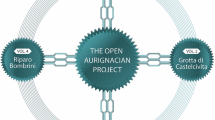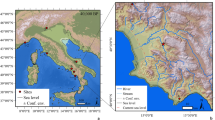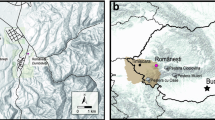Abstract
THE discovery of what seems to be the foundation of a hut, an alignment of six post holes, and two graves, one of which contains human remains in a remarkable state of preservation, provides important new information about the earliest Aurignacian occupation of northern Spain.
This is a preview of subscription content, access via your institution
Access options
Subscribe to this journal
Receive 51 print issues and online access
$199.00 per year
only $3.90 per issue
Buy this article
- Purchase on SpringerLink
- Instant access to full article PDF
Prices may be subject to local taxes which are calculated during checkout
Similar content being viewed by others
References
Carballo, J., Excavaciones en la Cueva del Rey, en Villanueva (Santander) (Memoria Num. 9, Junta Superior de Excavaciones y Antigüedades, Madrid, 1923).
Conde de la Vega del Sella, El Paleolitico de Cueva Morín y notas para a Climatologia Cuaternaria (Memoria Num. 29, Comisión de Investigaciones Paleontológicas y Prehistóricas, Madrid, 1921).
Gonzalez Echegaray, J., L. G. Freeman, et al., Cueva Morín: excavaciones 1966–1968 (Patronato de Cuevas Prehistoricas, Santander) (in the press).
de Sonneville-Bordes, D., l'Anthropologie, 58, 197 (1954).
Bordes, F., Quartär, 19, 251 (1968).
Author information
Authors and Affiliations
Rights and permissions
About this article
Cite this article
FREEMAN, L., ECHEGARAY, J. Aurignacian Structural Features and Burials at Cueva Morín (Santander, Spain). Nature 226, 722–726 (1970). https://doi.org/10.1038/226722a0
Received:
Issue date:
DOI: https://doi.org/10.1038/226722a0



